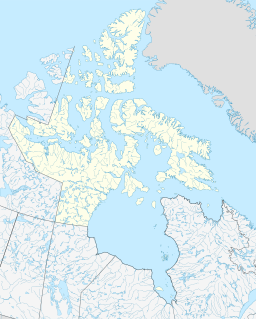|
Tanquary Fiord
Tanquary Fiord[1] is a fjord on the north coast of the Arctic Archipelago's Ellesmere Island, Nunavut, Canada. It is located in the Quttinirpaaq National Park and extends 48 km (30 mi) in a north-westerly direction from Greely Fiord. HistoryRadiocarbon dating methods suggest that between 10,000 and 4,100 BP, deglaciation occurred, followed by a period of glacial readvance and the formation of ice shelves until 2,400 BP. Until 1,400 BP, a period of glacial retreat occurred, and since then glacial readvance and nearby ice rises have marked the area.[2] Radiocarbon analysis of charcoal undertaken by the Geological Survey of Canada has shown that Inuit were present at Tanquary Fiord around 1070 BP at the latest.[3] GeographyThe head of the Tanquary Fiord is the convergence point of four river valleys, three of which end in a floodplain and one in a river delta. Carbon dating findings show that the fjord was free of glacial ice approximately 6,500 years ago.[4] In the past 40 years, the terminal points of side glaciers have receded.[5] Tanquary Fiord has 65 frost-free days per year (enough to grow lettuce), which is remarkable for its latitude. Summer temperatures of 18 °C (64 °F) have been recorded.[6] Human activityIn 1963, the Defence Research Board began 'Operation Tanquary' in the area, with a focus on oceanography. The operation concluded in 1972.[7] As the fjord is in a remote location, there is little human habitation. A Warden Station is staffed by Parks Canada during the summer months,[8] and Tanquary Fiord Airport is located nearby. It is possible to reach the area via charter aircraft, or increasingly via icebreaker cruise ships.[9] In 1947, a meteorological station was installed at Eureka, about 175 km (109 mi) southwest of the fiord.[10] The Fiord was named by Explorer Donald Baxter MacMillan in honor of his friend and fellow explorer Maurice Cole Tanquary.[11] See also the Crocker Land Expedition. References
|
||||||||||||||

